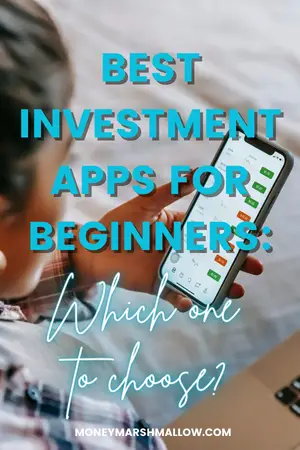The world of investing used to be an intimidating place, with high barriers to entry in both cost and knowledge. Therefore, it was often only those with a large amount to invest who entered the investment world, usually via a traditional financial advisor. However, with the fintech revolution of the last decade, the world of investing has opened up, and now we can look at the best investing apps for beginners, that can help make your first steps into the world of investing far easier.
Investing for beginners: Things to consider
Investing can be a great way to build your wealth, especially for long-term goals such as pensions. With the new products available, you can also start small and grow as your experience, knowledge and comfort level grows. However, there are a few things to bear in mind before you take the first step. Before exploring the best investment apps for beginners, let’s discuss some of the primary considerations.
Related: Investing for Beginners: A Complete Guide to Get Started
1. Risk
Any investment has risk. There is always the possibility of your investment becoming worth less than you originally put in, or even, in extreme cases, losing your entire investment. There are various ways that different investment platforms mitigate this. For example, you can invest in funds, which are baskets of different assets. So if one asset goes down in value, then it does not mean that your entire investment goes down.
2. Timescales
The timescale that you intend to invest for is very important. The shorter your investment timescale, the more risk you will need to incur to get any sort of decent return, but obviously, this means far more chance of losses. Therefore, it is much better to look to invest for the longer term, ideally several years or even decades. This mitigates the markets having bad years, such as after the crash of 2008.
3. Active or passive
Trading platforms will either be active or passive. This refers to the activity of the investor. If a platform involves active investing, then the investor has to make the decisions on which stocks, funds or other assets to buy. If a platform is passive, then it will have investment experts who will make the investment decisions for the investor. Robo-advisors and traditional financial advisors are examples of platforms that are passive, i.e. they create investment packages that you put your money into. Trading apps like eToro, Trading 212, and ‘execution-only’ platforms like Hargreaves Lansdown are active, so you will need to do the trades yourself.
On the active platforms, however, they will often have guides such as ‘best buy’ recommendations. Or in the case of eToro, its innovative Copy Trader function that allows you to copy the trades of successful traders on their platform.
4. What 'tax wrapper’ or product you will use for your investments
Many investment platforms will offer different products that you can use to put your investments into. Some of these are called ‘wrappers’ and this refers to a structure that you can use to invest as tax efficiently as possible. For example, Individual Savings Accounts (ISA) or Self-Invested Personal Pension (SIPP). Alternatively, platforms also offer general investment accounts, which have no special tax status, and just allow you to invest.
5. Amount you wish to invest
The amount you have to initially invest is an important point to note, as this will guide you to the best platform for you. Many people put off investing thinking that it’s only something for the rich. This is a common limiting money belief that just isn’t true.
Some of the robo-advisor platforms have a minimum investment of £100 or £500. With ‘execution-only’ platforms, you will generally have to pay a fee per trade of a few pounds. This means that if the amount invested is low, the cost is high. Automatic investment apps generally have minimum investment amounts of as low as £1.
Also, some apps such as InvestEngine and Trading 212 allow you to buy fractional shares. If you want to buy shares of a large company like Tesla, then you would need to spend something like £150 for one share. However, on these platforms, you can buy just a fraction of a share, so you can invest into the companies you want to with a lower initial cost.
Click here and join Trading 212 with my referral link to get a free fractional share!

Investment apps for beginners: What are the different types?
There are four main types of trading/investment platforms, and each one has strengths and weaknesses when beginning to invest. Below we’ll cover the main categories and provide some examples of the best investment apps for beginners under each type.
1. Automatic investment apps
Automatic savings apps are great for people who find it hard to put money away, whether to save or invest. These apps use open banking, which is a safe way that allows the apps to connect to your bank account and analyse your spending. They then calculate an amount they see you can easily afford to save or invest, and then move it into their platform. Some also have clever microsaving features like round-ups, which rounds up every payment to the nearest pound and invests the difference for you.
Once in their platform, they give the option of saving accounts, or investment funds, that put your money into baskets of investments, often divided by risk level. Automatic investment apps are generally passive, although some give the option to invest in individual stocks.
Benefits for beginners:
- Very easy to put money into your investments (maybe without even noticing!).
- Low minimum investment amounts.
- Platforms also have saving options.
Drawbacks for beginners:
- Will not give the opportunity to learn much about investment.
- If only investing a small amount each month (say from rounding up payments), then it could take a long time to build up a significant investment amount.
Notable providers:
- Chip
- Moneybox
- Plum – Get £5 free cashback if you have at least £100 in your Plum account for 90 days (Ts&Cs apply)
Related: Plum App: The Ultimate Review
2. Robo-Advisors
A robo-advisor is so named, as it is a case in which a robot has replaced a human! A traditional financial advisor will generally create the investment plan and make the trades for the investor. A robo-advisor does exactly the same thing, but uses algorithms to decide on the investment strategy for each customer based on their investment choices such as risk appetite, and whether they wish to do ethical investing or not. Robo-advisors will generally have lower fees than traditional financial advisors. Robo-advisors charge users an annual percentage of the amount that they have held as an investment with the platform.
Benefits for beginners:
- Very simple to invest.
- Lower costs than a traditional financial advisor.
Drawbacks for beginners:
- Not many opportunities to learn more about investing.
- Some robo-advisors have relatively high minimum investments.
Notable providers:
- InvestEngine – Get a Welcome Bonus of up to £50 when you invest at least £100 with InvestEngine (Ts&Cs apply)
- Moneyfarm
- Nutmeg
- Weathify
3. Free trading apps
Free trading apps have gained millions of customers in recent years, fuelled by publicity from events such as the Gamestop investment frenzy of 2021. Millions of investors in the UK and beyond downloaded the apps and started investing, attracted by being able to buy and sell stocks and shares for free.
Benefits for beginners:
- eToro’s Copy Trader is a great way to make the same trades as successful traders.
- Making trades is free.
- Can buy fractional shares.
Drawbacks for beginners:
- Some of these apps make more money from riskier investment types, such as CFDs, and may try to push their users to try these out, leading to a higher risk of losing money.
- There are often some ‘hidden’ fees that investors need to be aware of.
Notable providers
- eToro
- Trading 212 – Join Trading 212 with my referral link to get a free fractional share.
- Freetrade
3. DIY investment apps
DIY or execution-only investing refers to the fact that these apps are designed to allow investors to make their own trades. They do not offer financial advice, so users can only execute the trades on the platform. They are the most traditional of the four types of apps in this article in that they enable investors to buy the assets they wish to buy, charge a fee per trade, and then charge an annual percentage of the amount held with them by the investor.
These platforms involve active investing, so the investor makes their own choices of what to buy. However, they have extensive information and education about investing and provide guides and ‘best buy’ lists so investors can get tips.
Benefits for beginners:
- These platforms have extensive educational resources including forums.
- The platforms offer ‘best buy’ recommendations for assets to guide investors
Drawbacks for beginners:
- Each trade has a cost, so if your investment is small, this cost may make up a large percentage of your investment.
Notable providers
- InvestEngine – Get a Welcome Bonus of up to £50 when you invest at least £100 with InvestEngine (Ts&Cs apply).
- Hargreaves Lansdown
- Interactive Investor
Conclusion: Best investment apps for beginners
The many options can be overwhelming, but it really is the best time, thanks to financial technology, to make a start with investing. The best investment apps for beginners are those that offer low fees, ease of use, educational resources, and a diverse range of investment options. By choosing the right investment app, you can start your investment journey with confidence and make informed decisions about your financial future.

This guest post was provided by Wiseabout.money that features a wide range of reviews, comparisons, guides and more, to help you on your personal finance journey. The post may contain affiliate links. If you sign up through these links, we may earn a small commission at no extra cost to you, supporting our content creation.
